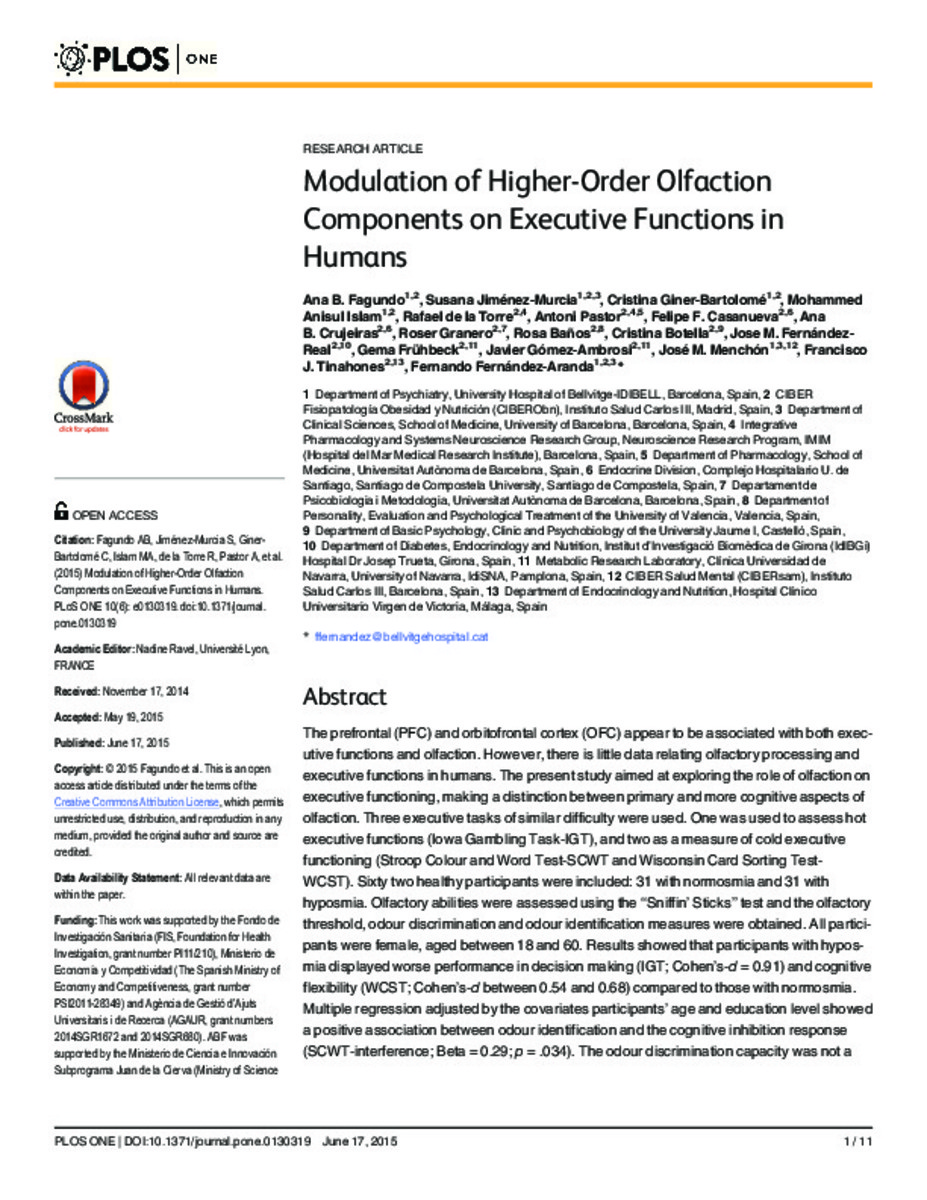Mostrar el registro sencillo del ítem
Modulation of higher-order olfaction components on executive functions in humans
| dc.contributor.author | Fagundo, Ana B. | |
| dc.contributor.author | Jiménez-Murcia, Susana | |
| dc.contributor.author | Giner-Bartolomé, Cristina | |
| dc.contributor.author | Islam, Mohamed A. | |
| dc.contributor.author | De la Torre, Rafael | |
| dc.contributor.author | Pastor, Antoni | |
| dc.contributor.author | Casanueva, Felipe F. | |
| dc.contributor.author | Crujeiras, Ana B. | |
| dc.contributor.author | Granero, Roser | |
| dc.contributor.author | Baños, Rosa Maria | |
| dc.contributor.author | Botella, Cristina | |
| dc.contributor.author | Fernández-Real, José Manuel | |
| dc.contributor.author | Frühbeck, Gema | |
| dc.contributor.author | Gómez Ambrosi, Javier | |
| dc.contributor.author | Menchón, José Manuel | |
| dc.contributor.author | Tinahones Madueño, Francisco Javier | |
| dc.contributor.author | Fernández Aranda, Fernando | |
| dc.date.accessioned | 2016-05-16T10:58:09Z | |
| dc.date.available | 2016-05-16T10:58:09Z | |
| dc.date.issued | 2015 | |
| dc.identifier.citation | Fagundo AB, Jiménez-Murcia S, Giner-Bartolomé C, Islam MA, de la Torre R, Pastor A, et al. (2015) Modulation of Higher-Order Olfaction Components on Executive Functions in Humans. PLoS ONE 10(6): e0130319. doi:10.1371/journal.pone.0130319 | ca_CA |
| dc.identifier.issn | 1932-6203 | |
| dc.identifier.uri | http://hdl.handle.net/10234/159639 | |
| dc.description.abstract | The prefrontal (PFC) and orbitofrontal cortex (OFC) appear to be associated with both executive functions and olfaction. However, there is little data relating olfactory processing and executive functions in humans. The present study aimed at exploring the role of olfaction on executive functioning, making a distinction between primary and more cognitive aspects of olfaction. Three executive tasks of similar difficulty were used. One was used to assess hot executive functions (Iowa Gambling Task-IGT), and two as a measure of cold executive functioning (Stroop Colour and Word Test-SCWT and Wisconsin Card Sorting Test-WCST). Sixty two healthy participants were included: 31 with normosmia and 31 with hyposmia. Olfactory abilities were assessed using the ‘‘Sniffin’ Sticks’’ test and the olfactory threshold, odour discrimination and odour identification measures were obtained. All participants were female, aged between 18 and 60. Results showed that participants with hyposmia displayed worse performance in decision making (IGT; Cohen’s-d = 0.91) and cognitive flexibility (WCST; Cohen’s-d between 0.54 and 0.68) compared to those with normosmia. Multiple regression adjusted by the covariates participants’ age and education level showed a positive association between odour identification and the cognitive inhibition response (SCWT-interference; Beta = 0.29; p = .034). The odour discrimination capacity was not a predictor of the cognitive executive performance. Our results suggest that both hot and cold executive functions seem to be associated with higher-order olfactory functioning in humans. These results robustly support the hypothesis that olfaction and executive measures have a common neural substrate in PFC and OFC, and suggest that olfaction might be a reliable cognitive marker in psychiatric and neurologic disorders. | ca_CA |
| dc.description.sponsorShip | Fondo de Investigacion Sanitaria (FIS) PI11/210 Ministerio de Economia y Competitividad PSI2011-28349 Agencia de Gestio d'Ajuts Universitaris i de Recerca (AGAUR) 2014SGR1672 2014SGR680 Ministerio de Ciencia e Innovacion Subprograma Juan de la Cierva JCI-2011-09248 Instituto de Salud Carlos III (ISCIII) | ca_CA |
| dc.format.extent | 11 p. | ca_CA |
| dc.format.mimetype | application/pdf | ca_CA |
| dc.language.iso | eng | ca_CA |
| dc.publisher | Public Library of Science | ca_CA |
| dc.relation.isPartOf | PLoS ONE 10(6): e0130319 | ca_CA |
| dc.rights | © 2015 Fagundo et al. This is an open access article distributed under the terms of the Creative Commons Attribution License, which permits unrestricted use, distribution, and reproduction in any medium, provided the original author and source are credited | ca_CA |
| dc.rights | Attribution 4.0 Spain | * |
| dc.rights.uri | http://creativecommons.org/licenses/by-sa/4.0/ | * |
| dc.subject | ventromedial prefrontal cortex | ca_CA |
| dc.subject | mild cognitive impairment | ca_CA |
| dc.subject | odor identification | ca_CA |
| dc.subject | decision-making | ca_CA |
| dc.subject | alzheimers-disease | ca_CA |
| dc.subject | piriform cortex | ca_CA |
| dc.subject | older-adults | ca_CA |
| dc.subject | deficits | ca_CA |
| dc.subject | discrimination | ca_CA |
| dc.subject | performance | ca_CA |
| dc.title | Modulation of higher-order olfaction components on executive functions in humans | ca_CA |
| dc.type | info:eu-repo/semantics/article | ca_CA |
| dc.identifier.doi | http://dx.doi.org/10.1371/journal.pone.0130319 | |
| dc.rights.accessRights | info:eu-repo/semantics/openAccess | ca_CA |
| dc.relation.publisherVersion | http://journals.plos.org/plosone/article?id=10.1371/journal.pone.0130319 | ca_CA |
Ficheros en el ítem
Este ítem aparece en la(s) siguiente(s) colección(ones)
-
PSB_Articles [1303]
Articles de publicacions periòdiques
Excepto si se señala otra cosa, la licencia del ítem se describe como: © 2015 Fagundo et al. This is an open access article distributed under the terms of the Creative Commons Attribution License, which permits unrestricted use, distribution, and reproduction in any medium, provided the original author and source are credited








